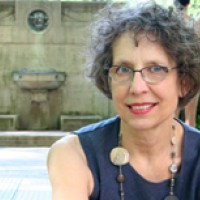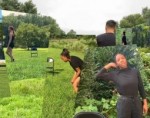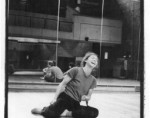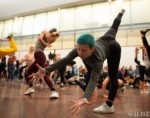
Photo: Luisa Parra and Daniel Pinheiro
Marlon Barrios Solano: Drawn to the Screen
by Lisa Kraus
Sherry Turkle, the sociologist/psychologist who rose to prominence as an early internet booster has changed her mind. Today, instead of continuing to marvel at the internet’s potentials she laments that our continual involvement with “screens” creates a culture where we are “alone together.” There are plenty who share her assessment.
Concurrent with this development, some researchers are investigating exciting and fruitful ways to connect through screens. Marlon Barrios Solano, who trained in dance, cognitive science and new media, works in ways that counter the sense of disembodiment and isolation that staring at screens can engender. Solano is drawn to screens but researches how the internet and the tools it provides offer not only ways of building community and sharing knowledge but also new ways to experience our bodies.
Solano describes himself as “a Venezuelan artist, researcher, consultant, educator, on-line producer/curator, video broadcaster and vlogger based between in USA and Germany.”He works as a Research Fellow at
HZT Berlin (Germany). The platforms he has created—
dance-tech.net, a social networking website, and the associated
dance-tech.TV, which produces and makes available a huge archive of recorded conversations and performances—engage 4,800 members and many more users globally. In the
Meta-Academy platform established last summer at the Bates Dance Festival, participants linked in from four continents for a three-week investigation into the “affordances” of the internet in exploring and co-creating content related to a shared topic of study.
Where do somatics and technology intersect? To reflect on this question the Meta-Academy group focused through a shared lens—
Nancy Stark Smith’s Underscore, a sequence of instructions for dancers that evolved through Stark Smith’s many decades of teaching contact improvisation. The Underscore functions as an organizational framework for a group of dancers wanting to jam together or, in this case, alone, sharing the outcomes through a live cam and images and stories posted later. It was chosen as a point of departure because of its adaptability as shared practice. Stark Smith’s articulateness regarding all aspects of her work, her curiosity about dialoguing with scientists and her intrepidness as an artistic experimenter made her an ideal collaborator.
Stark Smith offered multiple variants on the Underscore and related components during the three weeks at Bates. Here are her instructions, paraphrased, for a duet version where partners witness each other over screens as each dances in his/her own space:
ARRIVE settle in to textures, sensations, this moment, this body
PREAMBULATION circling into space, where you are, expand awareness to space, touch things,
see things, feel yourself
SETTLE IN, let your body drop, support rises from the ground, find small dance of balance,
standing and relaxing, reflexive actions, a moment of release, body mass resting on earth
mass, can feel this on your back or side or other side, feeling support rise, feel earth and gravity
from different directions.
WAKING UP reach or stretch, lengthen limbs, press into ground, feel connections from center
through arms and legs, feel own strength and support through body. Organize yourself to move
up in space. It’s not a one way street you might go back down. If something in room attracts you
you might want to reach for it, stretch, Can touch or move with or against furniture. NICE If you
get an opportunity to hang upside down.
AWARE of partner sounds without losing continuity of your own development.
MORE ATTENTION to partner, noticing composition wherever you might find it
RESOLUTION, DISENGAGEMENT, OPENING TO LARGER SPACE, less emphasis on partner
engagement
ENDING IN STILLNESS
REST, WARM DOWN, REVIEW what your experience has been
HARVEST by writing, drawing, thinking about it, breathing
EXPERIMENT to extend our presence into partner’s space. Seeing what kinds of
relationships we might make.

Pictured: Nancy Stark Smith and Yeong Wen Lee
Initially Stark Smith was skeptical about the potential for true “contact” when mediated through screens. But as her own playful sequencing through these instructions took off, she threw herself toward the screen and danced over and around the furniture in the classroom space she inhabited. Of course the possibilities for interaction were far different than what one would experience “live,” with actual touch, but the new possibilities seemed charged and very much of interest to her and her partner.
Starting off somewhat unsure about how full the connection could possibly be, Nancy Stark Smith ended up writing a piece, “Dancing Without a Body,” as an
editor note in the Contact Quarterly. In it she described being surprised at the level of engagement and feeling of connectedness possible by working online.
Can you imagine telecommuting to a dance class? At the Meta-Academy, that’s essentially what happened, as most of the participants were never in the same geographical space. Through the project, the group of 66 international participants took part free of charge, each week exploring new content areas through exercises taught by Stark Smith, “video encounters” where participants talked or danced online together, large group google hangouts with expert panelists in conversation around Stark Smith’s ideas, and experimentation with content creation in platforms like
Popcorn Maker and Twitter. The flow of activity mirrored the way the Underscore itself unfolds, with, for example, the first week dedicated to “arriving.” Participants made
screen tests—portraits that showed them in stillness, just being present. In the following week they made a series of photos showing their own environments—dogs and baby carriages included. This was about settling in, being aware of environment.
 Pictured: Jessica Muise and Felipe Torres Diaz
Pictured: Jessica Muise and Felipe Torres Diaz
Solano and co-directors Rachel Boggia and Josephine Dorado managed to fulfill their initial intention to increase digital literacy and create a shared platform for learning. As Solano described it in our phone interview, they wanted to “create an improvisational course where the way the form is reflects the content.”
The list of tools and activities also included real time tagging, word cloud visualizations, stories relayed on
Cowbird and snapshots on Flickr or Instagram, and a series of conversations with neuroscientists, theorists and dance artists to provide context for the experiments with embodiment and connection.

All the shared events are archived online.. The best way to comprehend the project’s scope and result is to navigate beginning here:
Meta-academy@Bates 2013: Minded Motion Lab. You can even try some of the experiments yourself and learn about the various online tools the group used, applying them to your own ends.
 Photo: Screenshot with, L to R, Nancy Stark Smith, Marlon Barrios Solano, Josephine Dorado, Rachel Boggia
Photo: Screenshot with, L to R, Nancy Stark Smith, Marlon Barrios Solano, Josephine Dorado, Rachel Boggia
In summer and fall of 2014 more collaborative online labs similar to the pilot at Bates are planned. This time around the focus will be (in Solano’s words) “Choreographic Practices: Ideas, Methods and Transmission of selected artists from several creative/artistic hubs.” A listing of locales follows this article.
How did Solano find his way to initiating this kind of project? Training in dance for ten years, his personal evolution followed a gradual path of weaving together the separate scientific and corporeal aspects of his interests. Solano particularly credits Gregory Bateson and Francesco Varela for deeply influencing his thinking—Bateson for his work in
cybernetics, and Varela for bringing attention to the effects of meditation and to the concept of embodiment within the field of psychology..
Solano found the improvisational work of David Zambrano (and that of the other seminal post-moderns that Zambrano brought to Caracas) to be a method for connecting dance with these scientific disciplines. He says “ideas of cybernetics were pervasive in the understanding of ‘new dance’—ideas of information in the body, feedback, in and outputs, how the body learns.” Zambrano’s work made that transparent, he adds.
A move to New York led to dancing with Lynn Shapiro and with Susan Marshall (1996-2001) as well as learning to write code, which brought Solano fully into working with the potentials of computer technology. In the nineties Solano saw with interest how Merce Cunningham investigated the use of the computer program (LIFE) forms for the creation of choreography, artists explored gesture as a way to control media with sensors placed on the moving body (think motion capture), and others experimented with connecting biology and dance with projects involving the manipulation of bacteria to develop scores for movement. Excited by these kinds of projects, Solano decided to dive fully into researching dance and technology, earning a masters degree at Ohio State University (2004). Since that time, Solano has enacted projects online, through
pop-up communities at arts festivals and through teaching.
 Photo: Marlon Barrios Solano
Photo: Marlon Barrios Solano
With all this as background, it’s no wonder that Solano brings a needed perspective to the integration of technology with artistic practice. Particularly now, when many schools are investigating online learning, and there are the first few
online dance courses being offered through major universities, Solano’s work with the Meta-Academy is especially timely.
Solano’s projects show how for dance the internet can be, instead of isolated bodies on screens, a platform for discovery, exchange and, most surprisingly, “moving” physical experience.
~ ~ ~ ~ ~
By Lisa Kraus
June 24, 2014
















